January 11, 2020
I can’t believe this is my last full day at Cristalino Jungle Lodge already. It thought it would be hard deciding what to do, but I hadn’t been with Rafael’s group in the morning yet, and I love going up to the Serra, so that’s where I spent the morning.
We had a bit of birding on our way there from the boat, including this raucous pair of Kawall's Parrots, distinctive with the lack of a white orbital ring and the white skin at the base of the bill.
We also saw this female Pompadour Cotinga from the boat – note the overall smooth gray color with a white iris.
On the way up the Serra we made sure to look at and smell this amazing orchid, Stanhopea candida, found by the group that came up here yesterday.
We perched on the highest granite dome for a while, hoping for a good mixed flock but none ever materialized. A flowering tree there was favored by this swallowtail, Battus crassus.
A common plant this time of year (completely absent in the dry season) is this sensitive plant, Mimosa skinneri.
We never did have a good mixed flock of tanagers, but we managed to work up one good mob with pygmy-owl imitations, seeing Black-bellied Thorntail and Gould’s Jewelfront. They were constantly buzzing around, so I didn’t get photos of them.
We descended the Serra early enough to take the Cacau trail, which leads back downriver, almost as far as the lodge (though on the opposite side). As we arrived at the start of the trail, our boatman Francisco was waiting for us, and also flagged down another passing boat to show us the poison dart frog he found while hiking back to the boat. This was once thought to be an undescribed species, but now is recognized as a local color morph of Adelphobates galactonotus. It is found only on the left bank of the Cristalino River, living on the granite domes.
A short ways down the trail I acted fast enough upon seeing a bit of movement in the trail to grab this tiny lizard, Loxopholis percarinatum. I’ve seen this microteiid (family Gymnophthalmidae) twice before here and once in Ecuador, and given how small and inconspicuous they are, I’d venture to say that it’s a very common and widespread species, even if you’ve probably never heard of it.
I didn’t even see this young Yellow-footed Tortoise (Chelonoidis denticulatus) right in the middle of the trail, having stepped right over it.
At lunchtime and during the break back at the lodge, I found this pair of Capybaras feeding by my cabin. I named them Frank and Betty, after two people I wish could have been here.
This Common Tent-making Bat (Uroderma bilobatum) was roosting in a new clump of Phenakospermum behind cabin 18. I had looked in the usual places around the staff clearing without finding any.
On the way back from lunch, a few of my friend had stopped to ogle this slug of larvae creeping along the ground. I knew they were sawfly larvae (a unique group of hymenopterans that don’t sting), later learning this is the genus Perreyia.
For the afternoon outing, I decided to do a fast walk all the way around Francisco’s Trail on my own, as I had never made a complete GPS track of it. At the start, I stopped to confirm that the Suriname Horned Frog (Ceratophrys cornuta) was still there!
I barely stopped for birds, but when I saw this turtle Platemys platycephala running in the trail, I had to stop for photos.
At nearly the same spot as the turtle I stopped at some activity in the canopy and caught sight of Dusky Titis, Callicebus moloch. The canopy was too dark for decent photos, but I’d never photographed this monkey before.
I led one last night walk. Our first good find was this Günther's Banded Tree Frog, Boana fasciata.
With a flutter suddenly in my face, I swiped out instinctively and lightning fast, and in my hand was this sphinx moth, Xylophanes chiron. When holding these, you have to be firm and not worry about what feels like a sting. They are very strong, can shed scales so as to be slippery, and the spines on their legs aren’t sharp enough to really hurt.
Just as instinctively, I didn’t reach out and grab this huge centipede, Scolopendra hermosa. The species in this genus in Arizona is known to have a very painful bite.
Best find of the walk was near the end – climbing vertically up a tree trunk next to the trail and about to enter a cavity was this Rainbow Boa, Epicrates cenchria. I gently lifted it off the tree and we quickly became BFF’s.
But eventually I had to reluctantly let it go.
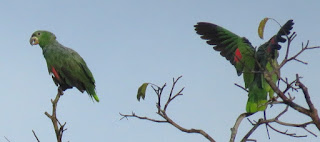
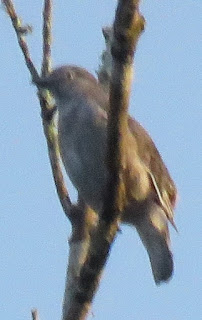
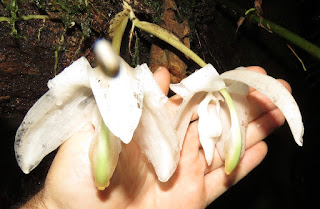



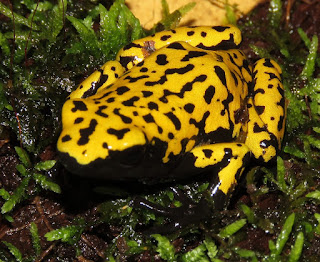



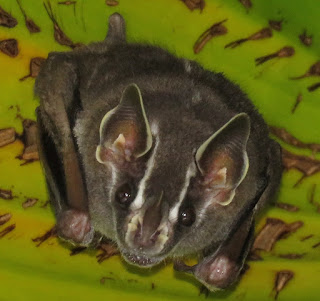



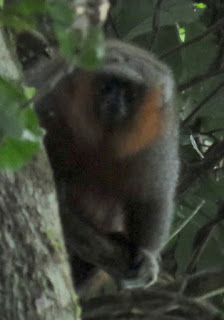

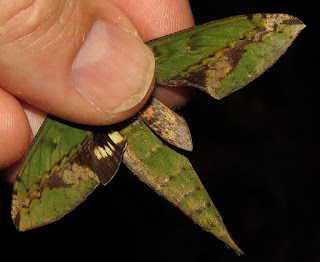

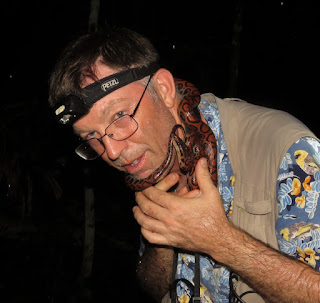






No comments:
Post a Comment